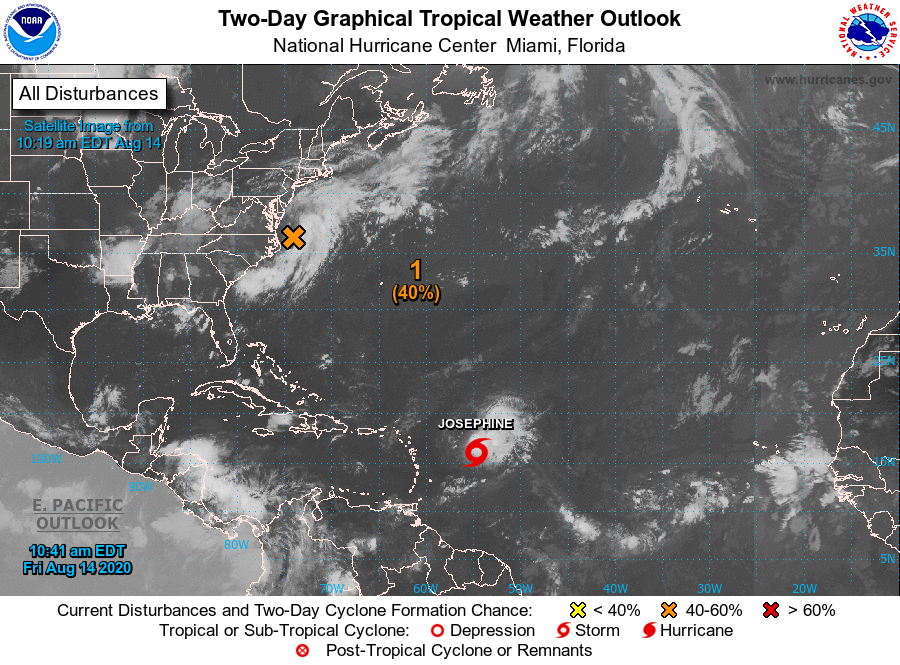 National Hurricane Center/Tropical Storm Josephine is heading north, northeast.
National Hurricane Center/Tropical Storm Josephine is heading north, northeast.
By NANETTE LoBIONDO GALLOWAY
As tropical storm Josephine gathers steam in the Atlantic Ocean, we're asking Downbeach residents if they are storm ready. Year 2020 proves to be an extremely active year for tropical storms and hurricanes. Josephine, the 10th named storm of the hurricane season, is also the earliest J named storm since storms have been given names. Her arrival, will eclipse Jose, which hit the U.S. on Aug. 22, 20005. Our last named tropical storm, Isaias, which affected every state along the Eastern seaboard, caused stormwater flooding and downed numerous trees causing power outages in the Downbeach area that lasted for several days. Isaias was also the earliest I named storm. In fact, all the named storms this season were earlier than normal.
Although there are no coastal watches at this time, Josephine could skirt the coast and cause flooding, high winds and damage.
Atlantic City Electric has offered its customers information about how to properly prepare for extreme weather events.
- Listen to weather forecasts and plan ahead.
- If you lose power, use flashlights. Do not use candles or kerosene lamps; they can create a safety hazard.
- Develop a family emergency plan that includes alternative arrangements should you need to leave your home. Make provisions for special needs family members such as the elderly, disabled, medically affected, or infants. If you are dependent on electric-powered medical equipment, seek alternate arrangements in the event of an outage.
- Have the following items on ready:
- Flashlights, not candles
- Fresh batteries
- Battery-operated clock radio
- Fully-charged cell phone
- Non-perishable foods
- Water: one gallon of bottled water per person per day without electric service. If your home is served by well water, fill a bathtub with water for sanitation use.
- Local maps
- Blankets
- Keep a first-aid kit in your home and in your car. Visit the FEMA Emergency Preparedness website for recommended items.
- Make a list of emergency phone numbers (including 1-800-833-7476 to report outages).
- Keep cash on hand.
Protect Your Food
To protect your food, keep refrigerator and freezer doors closed as much as possible. Food can stay frozen for 36 hours or more in a freezer if you keep the door closed. Consider freezing containers of water ahead of time and keeping them in the freezer to help your food stay frozen longer. For more information on keeping food safe during a power outage, check out
USDA Food Safety: Keeping Food Safe in an Emergency.
Protect appliances and electronic equipment
Many home electronics can be damaged during a power outage. Here are some ways to protect sensitive equipment:
- Purchase equipment with built-in surge protection or a battery-powered back-up system.
- Plug sensitive equipment into separate, grounded circuits to isolate them from fluctuations caused by major appliance restarts.
- Plug electronic equipment into electrical surge suppressors or arresters on properly grounded circuits.
- Consider having a lightning arrester installed at your main circuit panel.
- During a power outage, turn off all appliances, including your furnace, air conditioner, and water heater to avoid overloading circuits. Leave one lamp on so you will know when your service is restored.
- If you own a business or have a home office, consider installing an uninterruptible power supply for temporary backup power for your electronic equipment.
Get real-time updates
Familiarize yourself with important phone numbers and ways to get in touch in case of a power outage. We offer multiple services to help customers restore power and report outages.
- Call 1-800-833-7476 to report outages.
- Text "OUT" to 20661 to report an outage. Customers must first text "ADD OUTAGE" to 20661 to sign-up for the service
The AC Electric mobile app makes getting information quick and easy, and it's especially handy in the event of an outage as a result of a storm. By entering your My Account login, you can:
- Report outages
- Receive notifications for outage restoration progress
- Use interactive outage maps to check the status of outages in your area
Editor's Note: This is a first in a series of articles about how you can be storm ready.
Copyright Mediawize, LLC 2020
Advertise with us
 National Hurricane Center/Tropical Storm Josephine is heading north, northeast.
National Hurricane Center/Tropical Storm Josephine is heading north, northeast.